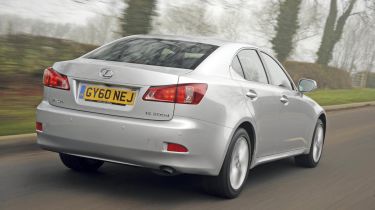Lexus IS 200d SE
Revamped four-door promises luxury and affordability
Over the past two decades, the Lexus brand has cultivated some serious premium car clout. However, despite this success, the firm’s IS models have failed to hit the mark in the competitive compact executive sector.
As a result, bosses have recently treated the saloon to a raft of updates in an attempt to lure customers into showrooms. Leading the charge is the new entry-level IS 200d, which promises to mix executive luxury with affordable running costs.
On the face of it, the Lexus has its work cut out in its quest for greater sales figures. Despite a number of visual modifications, it looks virtually identical to the model it replaces. It’s a handsome and well proportioned design, but it’s only after careful inspection that you’ll notice the revised front grille and headlamps, plus the new LED tail-light clusters and redesigned standard 17-inch alloy wheels.
Inside, the changes are equally difficult to spot, which means the same top-notch build quality, decent materials and switchgear that operates with oiled precision. Sadly, you also get the same dated design and slightly cluttered dashboard layout as the outgoing IS.
And with limited seat and steering wheel adjustment, you’ll find it harder to get comfortable in the Lexus than in the Passat. Occupants in the rear have a particularly raw deal. The car’s low roofline eats into headroom, while the large transmission tunnel leaves less space for legs. Finally, the miserly 398-litre boot – 167 litres less than the Passat – means the Japanese machine takes the wooden spoon in the practicality stakes.
Used - available now

2021 Audi
A6
28,288 milesAutomaticPetrol2.0L
Cash £27,400
2022 Vauxhall
Corsa
10,873 milesAutomaticPetrol1.2L
Cash £14,700
2025 BMW
i4
19,952 milesAutomaticElectric
Cash £31,000
2024 SEAT
Ibiza
28,777 milesAutomaticPetrol1.0L
Cash £14,500On paper, the IS 200d should have the upper hand when it comes to straight-line pace.
Its 2.2-litre diesel engine boasts 148bhp and a muscular 340Nm of torque – an advantage of 10bhp and 20Nm respectively over the VW – which allows it to set the pace with a 0-60mph time of 9.3 seconds. However, the use of tall ratios in the higher gears resulted in a lacklustre display during the in-gear tests.
In the real world, the difference in urge is even more marked, with the IS 200’s combination of a narrow powerband and clunky six-speed gearbox meaning you have to work harder to access the car’s performance potential.
For many owners in this sector, relaxing long-distance comfort is more important than hot hatch-rivalling pace – and the Lexus doesn’t disappoint.
A tall sixth gear means the IS 200’s engine is turning over at only 1,600rpm at 70mph, although the pay-off is sluggish acceleration. With its traditional rear-wheel-drive layout, you’d expect the Lexus to appeal to keen drivers. Yet while the chassis is poised and provides decent grip, it’s undermined by light steering that delivers minimal feedback. At least the ride is supple, with only severe potholes and motorway expansion joints upsetting its composure.
The IS 200’s hopes are dealt a further blow when it comes to finances. At £24,865, it will cost you £1,345 more than the better equipped Passat, while its CO2 emissions of 134g/km mean both company users and private buyers face bigger tax bills. The IS 200 faces an uphill battle for victory in this test.
Details
Chart position: 2
WHY: With lowered emissions and revised looks, the new entry Lexus IS 200d is designed to win the Japanese brand a host of new fans.







